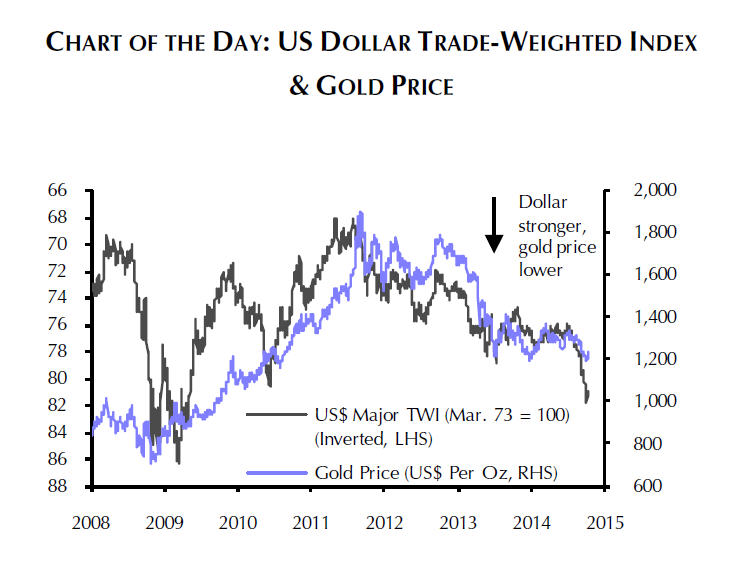 Commodities priced in US dollar usually have an inverse relationship to the world’s reserve currency.
Commodities priced in US dollar usually have an inverse relationship to the world’s reserve currency.
None more so than gold.
Given the current geopolitical environment (spurring safe haven buying) and what’s been happening on global financial markets (falling bond yields, tanking stocks and massive volatility), gold would be expected to be trading higher than today’s $1,240 an ounce.
But as this chart shows the recent strength in the gold price has been into the teeth of a rampant dollar.
Research house Capital Economics on Friday released the best chart I’ve seen to put the relationship between gold and the dollar in proper perspective.
Julian Jessop Head of Commodities Research at Capital Economics says for the third time since 2013 gold has found decent support at around $1,200 per ounce, but this time it’s different:
This latest episode is all the more remarkable given the strength of the US dollar. On the basis of the past relationship between the two, the price of gold might now be expected to be touching $1,000.
Jessop believes “any reduction in support for gold prices from US monetary policy could therefore easily be offset by new positives, including policy easing elsewhere, higher volatility in other asset markets and strong physical demand from emerging economies.”
Capital Economics’ house view is that the price of gold should rally to $1,300 per ounce next year, and to $1,400 in 2016.

Source: Capital Economics
3 Comments
peterpalms
You left out a 38% drop in purchasing power of the dollar caused by inflation in prices.There is only 5 cents left of the dollar earned in 1957 and another 2% is the cliff. heh, speak about falling off. Printing more federal reserve notes, that have the word “dollars” upon them, remain notes not money, legally counterfeited as “fiat”. Central banks around the world are buying gold with the federal reserve notes. Printing notes that have not been created by labor and services do not create jobs. Real money created by work and services increase the ability to consume and increase employment by virtue of increasing demand. Legal counterfeiting dose not create demand. What the FED intends is suicidal.
The actual inflation caused by the fed has been from $34.95 in 1957 for an ounce of gold, to today’s price October 8, 2014 destroying in the process the life savings of Americans who paid into social security all their working lives.
One thing is for sure: Real inflation is nowhere near the “official” 2 percent level. Given this data and the fact that corporate America gives pay raises based on the “official” CPI, it isn’t any wonder that America’s middle class is rapidly disappearing.
The S&P 500 previously hit an inflation-adjusted, all-time high in March 2000. Since then, US inflation, as measured by the Consumer Price Index (CPI), has climbed by almost 40%. Factoring that in transforms the previous record to 2,124, notes Epstein, and the market is still more than 5% below this milestone.
Meanwhile, the technology-heavy Nasdaq Composite has done far worse in real terms since 2000; investors in the Dow Jones index, on the other hand, have managed to make a small profit.
So, for example, an investor holding equities in the form of an index fund mirroring the S&P 500 from March 2000 has had a negative return when inflation is included. However, in general, most investors do not pay enough attention to analyze their returns accounting for adverse effects of inflation. The above chart brutally makes it clear that despite beating the market for 15 years the investor did not even make a positive real return.
The collapse of U.S. Silver inventory as public debt skyrockets.
http://www.silverseek.com/article/collapse-us-silver-stocks-public-debt-skyrockets-13593
peterpalms
One such asset the U.S. Government totally liquidated is its
massive stocks of silver. In 1940, the U.S. Treasury held 3,135,000,000 oz of
silver. That’s correct, 3.1 billion ounces. That is nearly
four times the current annual world mine supply of 820 million oz.
This figure is documented on page 64 in the USGS 1940 Gold-Silver Minerals Yearbook
You will also notice that the U.S. held nearly $22 billion of the total $30.5 billion in world gold reserves. This was
an amazing 72% (approximately 20,000 metric tons) of total world gold reserves.
Currently, the United States supposedly has 8,000 metric tons of gold in reserve. Unfortunately, we have no
way of knowing how much gold is really there and if so, how many claims are on each ounce. Some analysts such as Harvey Organ, believe the U.S. gold vaults are totally empty.
While it’s nearly impossible to know how much public gold remains in the vaults of
the U.S. Government, we have a pretty good idea of its silver inventories.
This concerns the massive decline in U.S. silver stocks from 1940 to present. As you can see, silver stocks at the U.S. Treasury
declined from 3.1 billion ounces in 1940 to 7 million ounces currently. This is a staggering 99.99% decline.
Now, if
we look at the Red line on the chart, we can see the huge increase in U.S. debt.
According to the Treasury Direct.gov August release, the U.S. debt
increased to $17.7 trillion. Compare that to the paltry $43 billion of U.S. debt
in 1940.
Interestingly, if we took the $43 billion (1940 U.S. debt) and divided it by 17.7 trillion (present U.S. debt),
it would equal 0.24% or a stunning -99.76% difference. Thus we have the following:
Change from 1940 to 2014
U.S. Silver
Stocks = -99.99%
U.S. Debt
Ratio = 00.24% or -99.75%
Looking at in a different way, the U.S. Treasury had $14 of debt on its balance sheet
for each ounce of its silver holdings in 1940, compared to $2.5 million of debt
per ounce of silver currently. We can only guess if the U.S. Treasury holds the
7 million ounces it shows on its books as it hasn’t updated that figure since
2000. (figures come from About.Ag)
Pieter
It might be sad for New York traders, but there is a country called China which drives commodity prices. It has been accumulating gold at a feverish rate and does not care about any notional pricing rules that might have held in the past whjen the US was morte globally significant than it is now